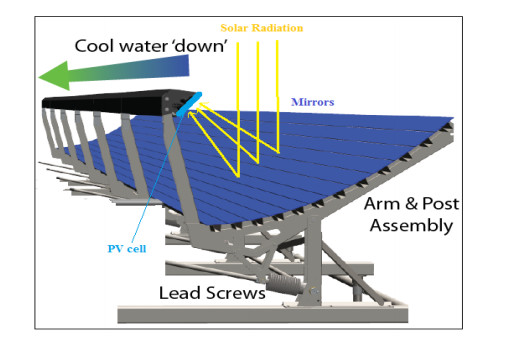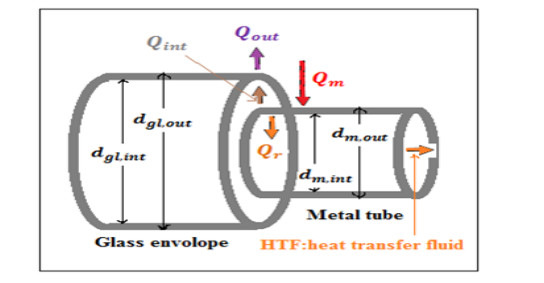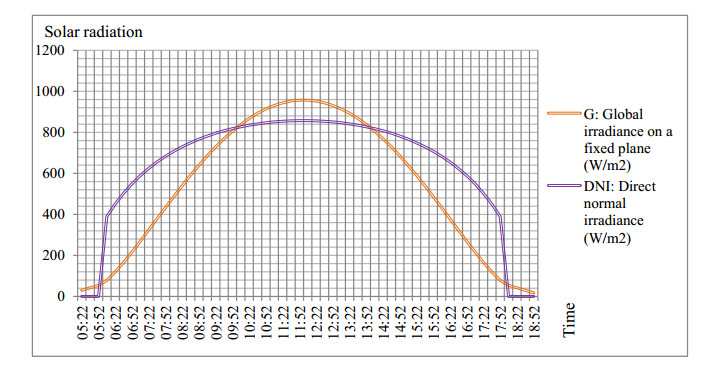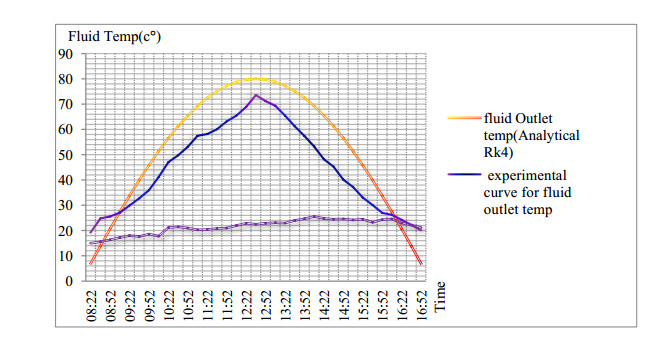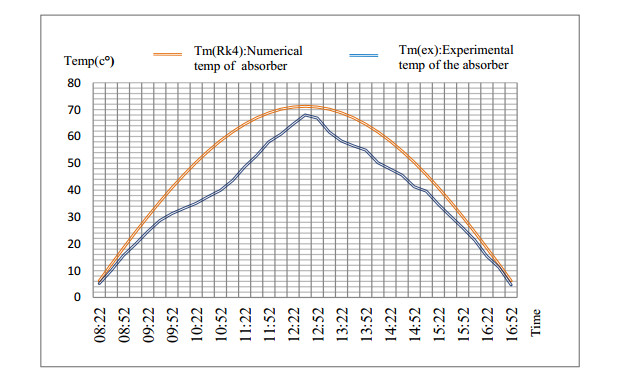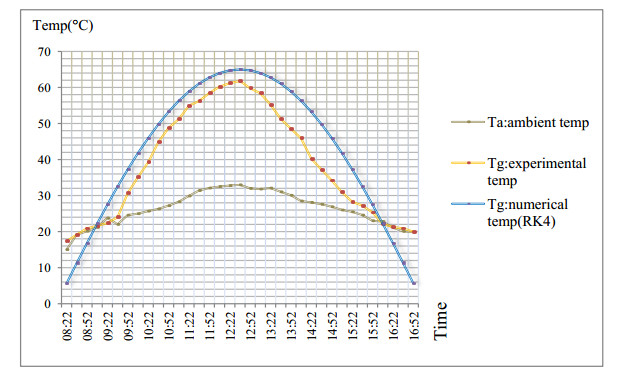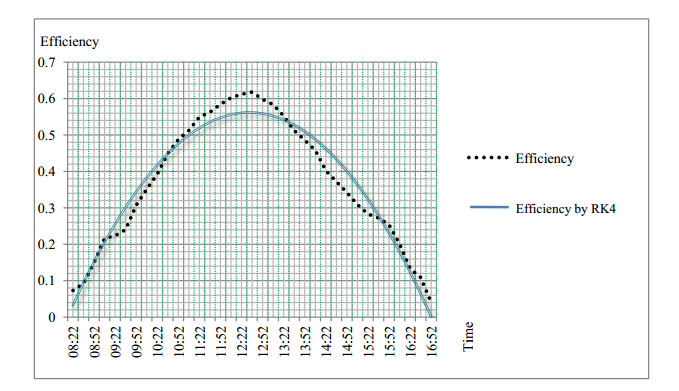This article is part of a theoretical study based on the mathematical analysis of the new technology of solar cogeneration using the parabolic trough concentrator and the photovoltaic cell. Our main objective is to study the thermal performance of the parabolic cylindrical concentrator in the Rabat-Salé-Kénitra region of Morocco. The methodology is based on solving the energy balance equation of the thermal collector whose elements are the absorber, glass and fluid. The performance of these equations is obtained by the Runge Kutta (RK4) method based on experimental data extracted from the PVGIS software. The numerical solution is found by the Matlab code. The validation test is verified on the studied region of Rabat-Salé-Kénitra. The results of the comparison between the numerical solution and the experimental data corresponding to the different temperature of the thermal collector are encouraging. Finally the thermal performance of the collector is satisfied.
1.
Introduction
In the first subsection of this section, we present introductory concepts related to the mining method selection problem. Further, we present a literature review. In the next subsections, we summarize the motivations, contributions and structure of the article.
1.1. Introductory concepts
Mining method selection (MMS) has been considered as one of the most problematic and critical tasks in mining engineering. The ultimate objectives of MMS are to maximize the profits of organizations and to recover the mineral resources. The MMS should be appropriate so that the companies can provide a safe environment to the miners facing the minimum problems between the feasible alternatives. The selection of the most suitable mining method is considered as a complicated task because it involves the consideration of various factors, including social technical, economical, and historical. The most appropriate mining method is the one which is technically suitable for the ore geometry as well as the ground conditions, while also proving to be a low cost task. The selection of appropriate mining methods is very important for the economic benefits of a country. The selection of an inadequate mining method may cause serious issues, such as serious waste of resources, low production capacity, low efficiency and high production costs. MMS becomes quite important when an ore body has been prospected [1]. MMS includes certain factors like economical, technical, political and environmental factors [2]. Moreover, the selection of a suitable mining method is a great challenge because it involves various factors which include uncertainty and fuzziness [3]. MMS consists of three stages [4]: 1) preliminary screening; 2) techno-economic analysis; and 3) comprehensive comparison. MMS has proved to be an interesting research topic for researchers. Some fuzzy based approaches for MMS can be seen in [5]. MMS can be considered as a complicated engineering problem. Different mining methods are available such as, integrated methods of medium-length hole cross-cut and subsequent filling mining, the in-pulse mining non-pillar contact sectional filling mining method, underground mining, room and pillar mining, etc. Thus, the selection of mining methods directly influences the economy of a country. In this study, we have considered a case study [6] of the Kaiyang phosphate mine which is located in Jinzhong Town, Guiyang City, Guizhou Province, China, to select the appropriate mining method for the Kaiyang phosphate mine. In this case study, five mining methods {M1,M2,M3,M4,M5} are evaluated on the basis of five criteria; i.e., technical feasibility, economic benefits, management complexity, security status and environmental benefits. The description of the under consideration mining methods is summarized in Table 1.
In recent years, many researchers have paid great attention to MMS based on fuzzy decision-making approaches.
1.2. Literature review
Zadeh [7] established fuzzy set (FS) theory a powerful model for proving and dealing with ambiguity in data through membership functions. FSs were drastically applied in Multi-criteria decision-making (MCDM) so that one can recover from the drawbacks and limitations of classical techniques. Later, Atanassov [8] proposed an extended version of FSs, called the intuitionistic fuzzy set (IFS), to overcome the shortcomings of FS theory. Furthermore, Yager [9,10] extended the theory of IFSs and proposed a broader structure called the Pythagorean fuzzy set (PyFS), which is denser and more powerful than IFSs. PyFSs are defined to relax the limitation of orthopair belonging degrees to the weaker supposition that μ2(x)+ν2(x)≤1 have to keep all through. Cuong and Kreinovich [11] proposed a generalization of the above concept, called picture fuzzy set (PFS), which consists of three membership degrees (MDs), that is, a positive MD (PMD) (μ), neutral MD (NMD) (ν) and negative MD (NeMD) (η)(μ+ν+η≤1). G¨undo˘gdu and Kahraman [12] and Mahmood et al. [13] proposed spherical fuzzy sets (SFSs) with the condition μ2+ν2+η2≤1 on three membership degrees. SFSs are considered as the new extension of PFSs and PyFSs. In decision-making (DM) problems, experts like to present their evaluations qualitatively. For example, experts wants to express their opinions through linguistic terms (LTs) such as "good", "bad", "excellent", etc. To represent data in LTs, Zadeh [14] pointed out the difference between numerical data and linguistic data. He established the concept of linguistic variables; which help to express human opinions effectively. After that, Zhang [15] proposed the concept of a linguistic IFS (LIFS), where both the PMD and NeMD are represented by LTs. Lin et al. [16] introduced the concept of a linguistic PyFS (LPyFS). Jin et al. [17] proposed linguistic SF aggregation operators (AOs). Herrera and Martínez [18,19] proposed the idea of a 2-tuple linguistic representation model (2TLRM) to better represent judgment and evaluation information in multi-attribute group decision-making (MAGDM) problems. Liu et al. [20] provided a solution to DM problems by utilizing different AOs. Further material can be studied from [21,22,23,24,25]. The 2TLRM is a valuable concept for processing data in linguistic DM problems, and researchers have paid great attention to it. Deng et al. [26,27] introduced the 2-tuple linguistic (2TL) Pythagorean fuzzy Hamy mean and Heronian mean AOs. Wei [28] proposed the 2-tuple intuitionistic fuzzy linguistic AOs. Abdullah et al. [29] studied 2-tuple spherical fuzzy linguistic (2TSFL) AOs. For the development and progress of a society, mineral resources are of great significance for mankind [30].
In the past, researchers have presented a variety of MAGDM methods and applied them to solve different problems. Brauers and Zavadskas [31] put forward the idea of a new method, called the multi-objective optimization ratio analysis (MOORA) method by providing its application in the field of economy. After the emergence of the MOORA method, an ordinary MOORA plus full multiplication form (MULTIMOORA) method was originated by Brauers and Zavadskas. In a study conducted by Brauers and Zavadskas [32], a fuzzy version of the MULTIMOORA method was established. Researchers conducted a survey on the MULTIMOORA method, and studied its history, development and applications [33]. In another study, Domínguez et al. [34] presented the intuitionistic fuzzy (IF) MOORA method to figure out the problem of supplier selection. Researchers studied and presented various extensions of the MULTIMOORA method, and they are available in [35,36]. In a study conducted by Garg and Rani [37], an IF MULTIMOORA was presented for the selection of solid waste management techniques. Some more extensions of the MULTIMOORA method and their applications can be studied from [38,39,40,41,42]. Sarkar and Biswas [43] introduced a Pythagorean fuzzy MULTIMOORA method. Baleˇzentis and Baleˇzentis [44] established the 2-tuple MULTIMOORA method and studied its application for supplier selection. G¨undo˘gdu [45] presented a spherical fuzzy extension of the MULTIMOORA method. Researchers proposed MULTIMOORA methods in different environments and presented their utilizations in different fields [46,47,48]. Recently, Akram et al. [49] introduced an extension of the MULTIMOORA method based on 2TLPyFSs. Wang and Triantaphyllou [50] presented a validity test for DM problems.
Karadogan et al. [51] presented an application of FS theory in MMS. Different methods of MMS through the analytic hierarchy process can be seen in [52,53,54]. Moreover, researchers have focued on MMS based on the Nicholas technique [55], an optimization model of unascertained measurement [56], fuzzy mathematics and catastrophe theory [57]. For further MMS techniques, one may refer to [58]. Yao et al. [59] presented a mining method of Kaiyang phosphorite and Wu et al. [60] also studied the Kaiyang phosphorite mine. Liang et al. [6] established a method for the selection of appropriate mining methods based on the linguistic MULTIMOORA method. Therefore, motivated by the above discussion, we were inclined to design the MULTIMOORA method while considering the 2TSFL framework, and to discuss its application in MMS. Table 2 presents an overview of FSs and their related extensions. The present study explores the theory of the MULTIMOORA method to broaden the DM methodologies for the remarkable notion of 2-tuple spherical fuzzy linguistic set (2TSFLS). The existing models of FSs such as IFSs and PyFSs, are competent in many aspects but their deficiencies paved the way for a new model, called the SFS model. The superior structure of SFSs enables the decision makers to represent their judgements without any loss of information. Moreover, the LTs have the excellent capability to address the evaluations presented by the decision makers in terms of phrases or sentences which are then converted in the form of 2TL terms (2TLTs). The notion of 2TSFL sets (2TSFLSs) is highly efficient in representing the data in terms of 2TSFL numbers (2TSFLNs). The MULTIMOORA method serves as a potent and powerful method to find the most appropriate alternative during the DM process. Furthermore, this method is based on three approaches namely, the ratio analysis (RA) approach, reference point (RP) approach and full multiplicative form (FMF) approach. The results obtained from these three approaches are considered in the final ranking of alternatives. From existing studies, we observed that there is no work available in the literature on the 2TSFL-MULTIMOORA method. Therefore, we aimed to build a MULTIMOORA method based on 2TSFLSs to deal with MAGDM problems.
Now we state some features of the proposed study are different from previous studies. First, the MULTIMOORA method has been introduced in various environments within the framework of FS theory as discussed in the literature review. But this method has not yet been studied for 2TSFLSs. For example, the 2TLPyF-MULTIMOORA method is able to demonstrate the evaluation information in terms of only two MDs which may lead to inaccurate results due to the loss of information. Therefore, we were inclined to study this method under the competent theory of 2TSFLSs. Second, we provided a comprehensive approach by establishing the proposed method to tackle DM problems. Therefore, we applied the presented technique to an actual case study which has not been studied for 2TSFLSs, which makes our work different from the existing studies.
1.3. Motivations
This paper describes an excellent MAGDM approach, namely, the 2TSFL-MULTIMOORA method, which consists of three approaches, and utilizes the dominance theory to reach the final result. Moreover, the proposed method consists of 2TL evaluations that benefit the experts' to make evaluations through LTs. We defended the proposed technique through a case study for the selection of a mining method for a phosphate mine. The overall motivation for this paper is summarized as follows:
● The SFS is a broader structure of existing FS theories, and it is a more generalized tool, having the ability to accommodate and manage considerably larger amounts of data than FS and its related extensions. An SFS consists of three MDs and it allows the experts to express their perspectives more clearly. Therefore, these salient features of SFSs motivate us to utilize it in our work.
● MAGDM problems are becoming more challenging for the experts with the passage of time. Sometimes it becomes quite challenging for the decision makers to give their judgements and preferences in numerical terms. LTs provide a broad range to the experts to represent their evaluation information qualitatively. Moreover, the 2TLTS overcomes the deficiencies of the classical LTS. In the 2TL model, the values are represented by a pair of elements, i.e., by (si,α), where si stands for the LT and α is the numerical value called its symbolic translation (ST). The above-mentioned properties of 2TLTSs motivate us to avail the notion of a 2TLTS.
● The 2TSFLS is the generalization of the SFS and the 2TLTS. The 2TSFLS combines the characteristics of the SFS and 2TLTS. The 2TSFLS expresses the MDs in the form of 2-tuples and enlarges the space to represent data accurately.
● The MULTIMOORA method is quite comprehensive and stable. It consists of three approaches, namely, the RA approach, RP approach and FMF approach and on their basis the alternatives were evaluated.
1.4. Contributions and structure of the article
Now, we state the contributions of this paper.
● We introduce a new normalized Hamming distance measure for the 2TSFLSs. In addition, we develop a new score and accuracy function to rank the 2TSFLSs.
● We present a MULTIMOORA method for the 2TSFLSs to cope with the challenges in MAGDM problems. From previous studies, we observed that there is a need to construct the MULTIMOORA method within the 2TSFL environment. Therefore, we decided to establish a MULTIMOORA method for the 2TSFLSs.
● We summarize the steps of the proposed strategy in a flowchart. The provided flowchart clarifies the procedure and makes each and every step of the presented method understandable.
● We demonstrate the applicability of the established method through a case study. We study the application of the proposed methodology in the engineering area. The provided case study is related to the selection of suitable mining methods.
● We describe a validity test to exhibit the effectiveness of the proposed methodology.
● We reveal the authenticity and superiority of the established approach by a comparative study.
The rest of the paper is summarized as follows: In Section 2, we review some basics related to the 2TLTS, SFS and 2TSFLS. In Section 3, we discuss an extended MULTIMOORA method based on the 2TSFLS along with a fully developed flowchart to better demonstrate the technique of the proposed method. In Section 4, we apply the proposed method to an application related to the selection of a suitable mining method for a Kaiyang phosphate mine, along with a validity test and a comparison analysis. Section 5 discusses some implications of the study. Finally, in Section 6, we present our conclusions, implications of the study, limitations and future research.
2.
Preliminaries
This section briefly recalls some fundamental notions, including the LTS, 2TLTS, SFS and 2TSFLS, which are important to comprehend the next sections.
Definition 2.1. [18,19] Consider an LTS t={tk:k=0,1,2,…,Θ} having odd cardinality, and where tk is the semantic of an LT corresponding to a linguistic variable. Consider the following example of an LTS t as:
An LTS should satisfy the following conditions:
● It should be ordered: tk>tl, ⟺ k>l.
● The max operator should be defined: max(tk,tl)=tk ⟺ k≥l.
● The min operator should be defined: min(tk,tl)=tk ⟺ k≤l.
● The negative operator should be defined: Neg(tk)=tl such that l=Θ−k.
The 2TLRM represents the linguistic assessments in terms of a 2-tuple (tk,μk). Here, tk is the semantic from the LTS t and μk indicates the value of symbolic translation, where μk∈[−0.5,0.5).
Definition 2.2. [18,19] Suppose that the result achieved after applying an aggregation on the indices of semantics in an LTS t is λ, where λ∈[0,Θ],; also, Θ+1 is the cardinality of t. Further, suppose k=round(λ) and μ=λ−k are the two values with k∈[0,Θ] and μ∈[−0.5,0.5),; then, μ is called symbolic translation.
Definition 2.3. [18,19] Consider the LTS t={tk:k=0,1,2,…,Θ} and λ∈[0,Θ]. A function Λ:[0,Θ]→t×[−0.5,0.5) which is utilized to transform λ into a 2-tuple (2T), is defined as follows:
Definition 2.4. [18,19] Consider the LTS t={tk:k=0,1,2,…,Θ} and a 2-tuple (tk,μk). A function Λ−1:t×[−0.5,0.5)→[0,Θ] which is utilized to transform a 2T to its nearest numerical value λ∈[0,Θ] is defined as follows:
Definition 2.5. [12,13] On a universe H, an SFS ξ can be defined as:
where α,β,γ:H→[0,1] denotes the PMD, NMD and NeMD, respectively, of the element z in ξ satisfying the constraint (α(z))2+(β(z))2+(γ(z))2≤1. For simplicity, the triplet (α,β,γ) is called the SF number (SFN). The degree of refusal membership of an SFN is given by the formula (1−(α(z))2+(β(z))2+(γ(z))2)12, ∀z∈H.
Definition 2.6. [29] Consider a 2TSFLS L in K as
where tα(z), tβ(z) and tγ(z) denotes the PMD, NMD and NeMD of the number z to the linguistic variable L having the restrictions tα(z),tβ(z),tγ(z)∈L, and 3≤(α(z))2+(β(z))2+(γ(z))2≤(Θ+1)2. For simplicity, we call L=((tα(z),A),(tβ(z),B),(tγ(z),C)) 2TSFLN with A,B,C∈[−0.5,0.5) and 3≤(Λ−1(tα2(z),A))+(Λ−1(tβ2(z),B))+(Λ−1(tγ2(z),C))≤(Θ+1)2.
Definition 2.7. [29] Suppose that the results achieved after applying an aggregation on the indices of semantics in an LTS t are a,b,c, where a,b,c∈[0,Θ], also, Θ is the cardinality of t. Further, suppose α=round(a),β=round(b),γ=round(c), are the three values and A=a−α,B=b−β,C=c−γ with A,B,C∈[−0.5,0.5), then, A,B,C are called ST.
Definition 2.8. [29] Consider the LTS t={tk:k=0,1,2,…,Θ} and a,b,c∈[0,Θ]. A function Λ:[0,Θ]→t×[−0.5,0.5) which is utilized to transform a,b,c into a 2T is defined as follows:
where round(.) indicates the usual round operation.
Definition 2.9. [29] Consider the LTS t={tk:k=0,1,2,…,Θ} and a 2TSFLS L as
then there exists a function Λ−1:t×[−0.5,0.5)→[0,Θ], that restores each 2TSFLN to its equivalent numerical value a,b,c∈[0,Θ], where
3.
2-Tuple spherical fuzzy linguistic MULTIMOORA method
This section introduces the process of the new 2TSFL-MULTIMOORA established on the basis of the classical MULTIMOORA method. In the first subsection, we define the normalized Hamming distance and a new scoring function. In the next subsection we describe the 2TSFL-MULTIMOORA method. The proposed 2TSFL-MULTIMOORA method has three methods: 1) the RA method, 2) RP method and 3) FMF method. The first five steps are the same for all three methods. In addition, we present a flowchart to demonstrate the steps of the proposed method graphically.
3.1. Hamming distance and scoring function
Definition 3.1. Consider two 2TSFLNs L1=((tα1,A1),(tβ1,B1),(tγ1,C1)) and L2=((tα2,A2),(tβ2,B2),(tγ2,C2)). The normalized Hamming distance is defined as:
Definition 3.2. Consider the 2TSFLN L=((tα,A),(tβ,B),(tγ,C)). The score function S of L is defined as
and its accuracy function A is defined as
3.2. 2TSFL-MULTIMOORA method
An MAGDM problem can be represented as a judgement matrix whose elements represent the judgement values of the alternatives corresponding to each attribute within the 2TSFL environment. Let ~Al={~Al1,~Al2,…,~Alm} be a family of m alternatives with a collection of n attributes ~AT={~AT1,~AT2,…,~ATn}. Consider a set of l experts' Ex={Ex1,Ex2,…,Exl}. Assume that ˜W=(˜W1,˜W2,…,˜Wn)T and ˜W=(˜W1,˜W2,…,˜Wl)T are the weights of attributes and the weights of decision makers, respectively. Moreover, it satisfies ˜Wj∈[0,1], n∑j=1˜Wj=1, ˜Wl∈[0,1] and l∑k=1˜Wl=1. The steps of the proposed MULTIMOORA method with 2TSFLNs are elaborated as follows:
Step 1. Construction of LTs: In the first step, the experts' construct the LTs to judge the alternatives which are summarized in Table 3.
Step 2. Construction of individual judgement matrices: Each of the experts set up an individual judgement matrix and present the judgement to analyze the alternatives on the grounds of attributes in the form of 2TSFLNs.
Step 3. Normalization of individual matrices: Usually, the attributes are of two kinds, i.e., the benefit type and cost type. In this step, each individual judgement matrix is normalized by utilizing the following fact:
Step 4. Construction of combined judgement matrix: The normalized judgement matrices are combined and a combined judgement matrix is constructed by utilizing the 2TSFL weighted averaging (2TSFLWA) operator [29] as given in Eq (3.4).
The judgements of alternatives ~Ali(i=1,2,…,m) corresponding to each attribute Cj(j=1,2,…,n) are represented in terms of 2TSFLNs as Cj(~Ali)=Lij=((tαij,Aij),(tβij,Bij),(ˆlγij,Cij)). The combined judgement matrix D=Cj(~Ali)m×n is presented as follows:
Step 5. Construction of weighted combined judgement matrix: The weighted combined 2TSFL judgement matrix of the alternatives corresponding to each attribute is constructed in this step by utilizing the attribute weights ˜Wj(j=1,2,…,n) and Eq (3.6).
The weighted combined 2TSFL judgement matrix D=Cj(~Ali˜W)m×n can be defined as:
First approach: RA approach
Step 6. Calculation of Y+i values: In the first step of the approach, the Y+i values are calculated by utilizing the 2-tuple spherical fuzzy linguistic averaging operator as follows:
Step 7. Calculation of score values: The scores of Y+i values are computed by using Eq (3.9).
After the determination of scores, the alternatives are arranged in descending order based on Eq (3.9). The alternative possessing the highest score is regarded as the best one.
Second approach: RP approach
Step 6*. Calculation of scores of the weighted combined 2TSFL judgement matrix: The scores of the weighted combined 2TSFL judgement matrix determined in Step 6 are computed by using Eq (3.9).
Step 7*. Determination of RPs. In this step, the RPs are determined by utilizing the Eq (3.10).
Step 8*. Computation of alternatives distance from reference points: In this step, the distance of each value of the alternative from the RPs is calculated by using Eq (3.11).
Step 9*. Computation of maximum distance: Find the maxd(~Alij,x∗ij) of the alternatives and assign an order to each alternative accordingly minimaxjd(~Alij,x∗ij). In other words, the alternatives are ranked on the basis of variation from the RPs and the alternative possessing the minimum variation (distance) from the RPs is regarded as the best one.
Third approach: The FMF approach
Step 6**. Determination of Ai values: The Ai values based on the 2TSFL geometric (2TSFLG) operator [29] given in Eq (3.12) are computed.
Step 7**. Calculation of score values: The scores of the Ai values using Eq (3.9) are calculated.
Step 8**. Finding the feasible alternative: In the last step, the alternatives are ranked on the grounds of the scores as determined in Step 7** and the alternative possessing the highest score is regarded to be the most feasible one.
The final selection of the best alternative is made on the idea of dominance theory in which the alternative possessing the highest number of appearances is regarded as the most feasible one.
4.
Application: Selection of optimal mining method
In this section, we applied the proposed 2TSFL-MULTIMOORA method to a case study which is related to the selection of the mining method for the Kaiyang phosphate mine. In the first subsection, we describe the application of the established approach to a case study. In the second subsection, we provided a validity test and the last subsection presents a comparative analysis.
4.1. Description of the problem
Mining is considered a source of employment for the public, and it is very important to contribute to local and regional communities. It plays a very important role in stimulating economic growth. Mining produces a team of trained workers and small businesses that can initiate the small businesses and serve communities. In this subsection, we have considered a case study [6] of the Kaiyang phosphate mine which is located in Jinzhong Town, Guiyang City, Guizhou Province, China. Maluping, Qincaichong, Yongshaba and Shabatu are the four sections of mine area. The phosphate reserve consists of 1.08 billion tons and the ore body is 2880 m in strike having a thickness of 4.5–8.2 m with an inclination angle of 20o–45o. In this case, it is important to adopt a proper cut-and-fill stoping technique by using phosphogypsum and yellow phosphorus slag as filling materials. The data presented in the judgement matrices has been taken from [6]. The Kaiyang phosphate deposits are presented in Figure 2. Regarding choosing an appropriate mining method, there were five mining methods available {M1,M2,M3,M4,M5} [59] as presented in Table 1. Three experts {Ex1,Ex2,Ex3} were invited to select the mining method on the basis of five attributes {TF,ECB,MC,SS,EVB} which are displayed in Figure 3. MC is the cost type attribute and TF,ECB,SS,EVB are the benefit type attributes. It was assumed that all three experts' have equal weight. The experts assigned the weight vector ˜W={0.28,0.13,0.10,0.26,0.23} to the attributes. We utilized the Microsoft Excel software for numerical computations.
The steps of the 2TSFL-MULTIMOORA method are summarized as follows:
Step 1. Table 3 represents the LTs along with their semantics provided by the experts.
Step 2. Tables 4–6 represents the LTs for the individual judgement matrices in the form of the 2TSFLNs assigned to each alternative on the basis of attributes.
Step 3. Tables 7–9 summarizes the normalized decision matrices in the form of 2TSFLNs.
Step 4. Table 10 presents the collective judgement matrix that was obtained by applying the 2TSFLWA operator (Eq (3.4)).
Step 5. Table 11 shows the weighted combined 2TSFL judgement matrix by using the attributes weights ˜Wj(j=1,2,…,n) and Eq (3.6).
First approach: RA approach
Step 6. Table 12 gives the Y+i values based on the 2TSFLA operator (Eq (3.8)). Step 7. Table 12 summarizes the scores of Y+i values and their ranking orders which are computed by applying Eq (3.9).
Second approach: RP approach
Step 6*. Table 13 shows the scores of the weighted combined 2TSFL judgement matrix. Step 7*. Table 14 displays the RPs that were obtained by applying Eq (3.10). Step 8*. Table 15 summarizes the distance matrix which is computed by using Eq (3.11). Step 9*. Table 15 presents the maximum distance, maxd(~Alij,x∗ij) of each alternative and its ranking based on minimaxjd(~Alij,x∗ij).
Third approach: FMF approach
Step 6**. Table 16 shows the Ai values which are calculated on the basis of the 2TSFLG operator (Eq (3.12)). Step 7**. Table 16 represents the scores of the Ai values which are determined by utilizing Eq (3.9). Step 8**. Table 16 presents the ordering of alternatives in descending order.
The final ranking of the alternatives is summarized in Tables 17 and 18. Figure 4 indicates the ranking positions of alternatives based on the RA approach. It is easy to see that the ranking position of Alternative M1 is first. The ranking positions of the remaining alternatives can be observed in a similar way. In a similar fashion, we can observe the ordering of alternatives from Figures 5 and 6 based on the RP approach and FMF approach, respectively. Figure 7 graphically displays the ranking positions of the five mining methods.
4.2. Validity test
In this subsection, we describe the application of a testing criteria [50] to our presented method to demonstrate its effectiveness. The criteria is given as follows:
1) Test criterion 1. An effective MAGDM method should remain unchanged in terms of replacing the judgement values of a non-optimal alternative with a worst alternative without changing the importance of each criteria.
2) Test criterion 2. An effective MAGDM method should satisfy the transitive property.
3) Test criterion 3. The alternatives ranking should remain unaltered in terms of dividing the MAGDM problem into smaller sub-problems. That is, by applying the same method to smaller sub-problems, the alternatives ranking should remain the same.
Now, we will describe the test for the validity of the presented MAGDM technique, which was conducted by applying the above-mentioned criteria.
● Validity test by Test criterion 1. If we change the judgement values of a non-optimal alternative M2 with the worst alternative M′2 in the matrices presented by the experts; these values for the worst alternative M′2 are summarized in Table 19. The ranking orders along with the final ordering of the alternatives after applying the proposed method, are given in Table 20. It is easy to see that the optimal alternative is M1, which is the same as that of the original ranking. Hence, our proposed method holds the test criterion 1.
● Validity test by Test criterions 2 and 3. Now to validate the test criterions 2 and 3, we split the problem into smaller sub-problems, i.e., {M1,M2,M3}, {M2,M3,M4}, {M3,M4,M5} and {M4,M5,M1}. After applying the established method on these sub-problems, we get the ranking order as M1>M2>M3, M4>M2>M3, M4>M3>M5 and M1>M4>M5. The overall ranking order of alternatives was M1>M4>M2>M3>M5, which is the same as that of the original ranking. Hence, the proposed method is validated under test criterions 2 and 3.
4.3. Comparative study
In this section, we compared the ranking results of the proposed method with the existing AOs and MAGDM methods available in the literature. The main calculation steps are summarized as follows:
● We computed the results of the presented application from the literature defined in [17]. First, we utilized the spherical fuzzy linguistic ordered weighted averaging (SFLOWA) operator to combine the individual judgement matrices. Further, we utilized the spherical fuzzy linguistic weighted averaging (SFLWA) operator. The combined values along with the scores and ranks of alternatives are shown in Table 21. From Table 21, the ranking order of alternatives can be observed as M1>M4>M2>M3>M5.
● We calculated the results of the presented application from the literature defined in [17]. First, we utilized the spherical fuzzy linguistic ordered weighted geometric (SFLOWG) operator to combine the individual judgement matrices. Further, we utilized the spherical fuzzy linguistic weighted geometric (SFLWG) operator. The combined values along with the scores and ranks of alternatives are shown in Table 22. It can be easily observed from Table 22 that the ranking order of alternatives was M1>M2>M4>M3>M5.
● We calculated the results of the application presented in Section 4 by using the 2TLPyF-MULTIMOORA method [49]. We computed the ranking results by neglecting the NMD and considered the PMD and NeMD. The decision matrices obtained by ignoring the NMD are presented in Tables 23–25. First, we estimated the results by utilizing the three approaches namely: the RA approach, RP approach and FMF approach. Then, we applied dominance theory for the final ranking of the alternatives. The ranking results of the alternatives are summarized in Table 26.
● Now we estimate the results by using the SF-MULTIMOORA method [45]. To do this we first transform the LTs into fuzzy values as defined in Table 27. The results estimated by using the SF-MULTIMOORA method are listed in Table 28.
The ranking positions of the five mining methods along with the optimal alternative obtained by utilizing the proposed 2TSFL-MULTIMOORA method and the existing AOs, are summarized in Table 29. The ranking positions of the alternatives are summarized in Figure 8. From the above comparison, we noticed that the ranking positions of the five mining methods obtained by using SFLWA are consistent with the ranking positions of our proposed method. But, the ranking positions of the alternatives are different in the case of the SFLWG operator. However, their optimal alternative is the same. When we computed the results by using the 2TLPyF-MULTIMOORA method, we observed that the ranking positions of the alternatives are consistent with our proposed method. In some situations, it might be possible that we would obtain different results by utilizing the 2TLPyF-MULTIMOORA method owing to the absence of an NMD. The ranking results obtained by using the SF-MULTIMOORA method are quite different from our proposed results. This is due to the fact that this method is unable to deal with the 2TL information. On the other hand, our established method is capable of dealing with the 2TSFL information. Now we state the highlights of the developed 2TSFL-MULTIMOORA method given as follows:
1) The MULTIMOORA method has some remarkable features. This method consists of three different approaches including, the RA analysis approach, the RP approach and the FMF approach. As it integrates the three aforesaid approaches, it is more reliable for ranking the alternatives.
2) The proposed 2TSFL-MULTIMOORA method has the ability to express the experts' evaluations qualitatively, i.e., in terms of 2TL values. It provides the freedom for the expert to express their opinions about alternatives in terms of three 2TL degrees (PMD, NMD and NeMD). Hence, the developed 2TSFL-MULTIMOORA method is more robust, reliable, simple and stable as compared to the existing approaches.
5.
Implications of the proposed study
In this section, we discuss the managerial implications in the first subsection. In the second subsection, we highlight some practical implications of this study.
5.1. Managerial implications
Given the above results, the proposed model has managerial implications in terms of enhancing the selection of the best alternative in MMS. First, the established methods implemented in the 2TSFL environment allow experts to express their opinions and evaluations by using LTs. Therefore, the proposed strategy effectively addresses the practical MAGDM problem under the conditions the of 2TSFLSs. Thereafter, the established method was shown to provide a flexible way to gather information on real-world LTs. Second, the MULTIMOORA approach has proven properties such as timely DM as well as an ease of understanding and implementation. It combines three methods, and the results obtained from all three methods were used to determine the final location of the alternatives. In addition, the method also has the ability to synthesize expert evaluations. Therefore, the developed method provides a systematic, comprehensive and efficient evaluation of the alternatives in the MAGDM problem. All in all, experts can implement the established methods to select the most suitable alternatives, as shown in the considered case studies.
5.2. Practical implications
This study proposes a 2TSFLS-based extension of the MULTIMOORA technique. Some practical implications of the studies described are as follows:
● In this paper, we have discussed a case study that selects the most suitable mining method from a set of available mining methods based on certain criteria. Furthermore, we have applied an extended MULTIMOORA method for this purpose within the framework of 2TSFLSs. In this case, we successfully achieved our goal by utilizing the proposed method to select an appropriate mining method. Therefore, the proposed method is easy to understand and can practically solve the MAGDM problem. The proposed method not only exhibits 3D data in terms of SFNs, but also accommodates the salient features of 2TLTSs.
● We proposed a normalized Hamming distance measure for 2TSFLSs. Furthermore, we developed a novel score and accuracy function to rank 2TSFLNs.
● We conducted a comparative study of the proposed method to test the effectiveness and superiority of the developed method. In addition, we performed a validity test to judge the significance of this study.
● It can be easily seen that the most suitable mining method using the proposed method is the same as determined in [6].
6.
Conclusions, limitations and future research
In this section, we first present the concluding remarks of this study. Further we highlight the limitations and future directions.
6.1. Concluding remarks
MMS has been considered as an essential task in mining engineering and the most suitable mining method holds great importance in mining projects. In accordance with the important characteristics of MMS, this proposed 2TSFL-MULTIMOORA method has been applied to provide the optimal solutions of an MMS problem as well as those in other MAGDM domains. As an extension of the PFS, SFSs are considered as an excellent model to present uncertain and ambiguous information. Furthermore, 2TSFLSs consist of three MDs (PMD, NMD, NeMD), which are represented by 2-tuples. The experts' evaluations may often contain some uncertainty and vagueness while facing complicated evaluation surroundings. Thus, we utilized 2TSFLNs to express the evaluation proposed by the decision makers. Moreover, there are different evaluation parameters, including those related to the environment, economy, etc., that may have interactions with each other. Hence, 2TLSFWA operators have been utilized to demonstrate their inter-relations. After that, a case study to select the most feasible mining method (Kaiyang phosphate mine) using the proposed 2TSFL-MULTIMOORA method has been presented. We also described a validity test for the established technique that was used to justify the authenticity of our method. We provided a comparative study to reveal the authenticity of the developed method.
6.2. Limitations
The limitations of the proposed research are summarized as follows:
● It is able to manage the 2TL information when the sum of squares of three DMs is less than Θ+1. This method is unable to handle information when the sum of squares of three MDs exceeds from Θ+1.
● In some situations, it becomes difficult to manage data due to unclear information. More precisely, some results are valid only for particular situations.
● The quantitative measurements become complicated due to the presence of uncertainty and ambiguity in the structure of fuzzy alternatives.
6.3. Future research
Our future research goals are listed as below.
● The spaces of 2TL information can be broadened by considering the data under the condition of T−SFSs (T≥1).
● The MULTIMOORA method can be generalized for 2TL T−SFSs and its applications can be studied in various other fields other than MMS.
● Future research may contain a variety of evaluation data on the aggregation of the 2TSFLNs utilizing various AOs such as the Hamy mean, Einstein, Heronian mean, Hamacher operators, etc.
● 2TL information can be further processed under many hybrid theories, such as, hesitant FSs, hesitant IFSs, hesitant PFSs, and hesitant PyFSs.
Acknowledgement
The fourth author extends his appreciation to the Deanship of Scientific Research at King Khalid University for funding this work through the General Research Project under grant number (R.G.P.2/48/43).
Conflict of interest
The authors declare no conflict of interest.









 DownLoad:
DownLoad:










